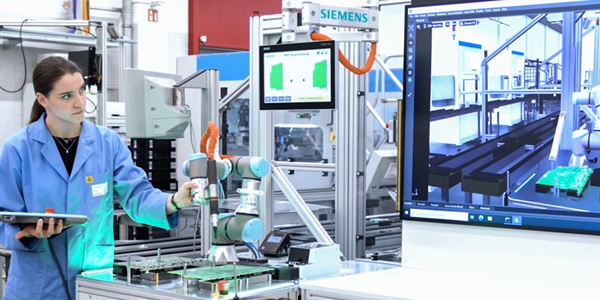
NAA Member News: Siemens – the Turning Point in Industrial Automation: Bringing Generative AI to the Shopfloor
From 20 years to just three years – that’s how dramatically factory floor experience has plummeted since 2019.
This shift creates significant challenges:
- Loss of domain-specific know-how and longer employee training periods
- Rising pressure on operational cost
- Reduced efficiency due to higher risk of quality issues
But here’s where it gets interesting: We’re not just filling this gap – we’re transforming it into an opportunity. By combining decades of industrial expertise with the power of Generative AI, we’re creating something that hasn’t existed before: AI that truly understands the language of engineering. AsBarbara Humpton, CEO of Siemens USA, put it:
“Generative AI expands what’s humanly possible by enabling workers to speak with machines – without needing technical skills. This brings people off the sidelines and into manufacturing, where they can learn on the job and advance to high-skill positions.”
Turning point in industrial automation: bringing generative AI to the shopfloor
In 2023, we developed in collaboration with Microsoft & Schaeffler, the first Industrial Copilot – a PLC (Programmable Logic Controller) code generator. This marked a breakthrough in industrial automation, addressing a 45% decline in PLC programming expertise over the past decade.
That was already a significant turning point – but now, we’re entering an even more revolutionary phase of industrial AI, with models that truly understand the language of engineering and empower engineers to develop PLC code faster and with greater precision.
The Industrial Foundation Model: AI that speaks factory
Imagine AI that doesn’t just understand words, audio or images, but actually knows what makes a factory tick. That’s our Industrial Foundation Model (IFM) – and it’s fundamentally different from conventional AI. It’s a key trend in the area of industrial generative AI that our experts consider to be one of the most important today.
Unlike ChatGPT or other commercial AI models trained on internet data, our IFM is built from the ground up with industrial DNA. It will understand real factory data, from sensor readings to production workflows – speaking the language of engineering by interpreting modalities like PLC code or CAD designs. Most importantly, it will connect the dots across industrial operations, from shop floor to top floor.
Think of it as an industrial brain. One that knows how to understand complex P&ID diagrams and generate precise CAM programming. It’s trained on decades of manufacturing expertise, real production data, and actual factory operations. This means it will be able to tackle specific challenges that general AI simply can’t touch.
Real-world use cases are already emerging
The potential of an Industrial Foundation Model is vast, with many use cases that could significantly enhance operational efficiency. For instance, one promising application lies in CAM programming: Our vision is to develop an AI-powered system built on an Industrial Foundation Model, that transforms CAM programming by identifying machining features and suggesting cutting strategies, tools, and toolpaths. Through an intuitive interface, users can ask questions and receive tailored recommendations. The goal is to automate complex tasks, reduce reliance on expert skills, and accelerate the manufacturing workflow.
Another promising use case is in the acceleration of P&ID development. By reducing complexity and manual effort, engineers could use a copilot powered by an Industrial Foundation Model to generate and refine diagrams using inputs like PFDs, historical P&IDs, and design standards. The copilot would then produce outputs in DEXPI format and offer intelligent suggestions in real time – helping teams work faster, maintain compliance, and drive consistency across projects.
These examples showcase the transformative power of our Industrial Foundation Model, marking a major leap forward in how we approach resilience, innovation, and scalability in manufacturing and automation. It’s not just about replacing expertise – it’s about augmenting human capability and unlocking entirely new possibilities.
“An IFM that speaks the language of engineering and understands diverse industrial contexts such as mechanics, electronics/electrical engineering, and software could enable industry to finally realize the promised potential of GenAI,” says Tali Segall, Head of Industrial Foundation Model at Siemens.
To develop industrial-grade AI solutions like Industrial Foundation Models (IFMs), we need real-world, contextualized datasets. Siemens leverages its own extensive engineering data across mechanical, electrical/electronic, and software domains. But to push the boundaries further, we’re inviting partner companies to contribute their contextualized data and collaborate on shaping the next generation of industrial AI. Through federated learning, the value grows for everyone – like assembling a puzzle, each contribution reveals more of the full picture. Together, we can create AI that understands engineering.
Join us in this journey to revolutionise industry. To learn more about IFM and connect with our experts, click here.





